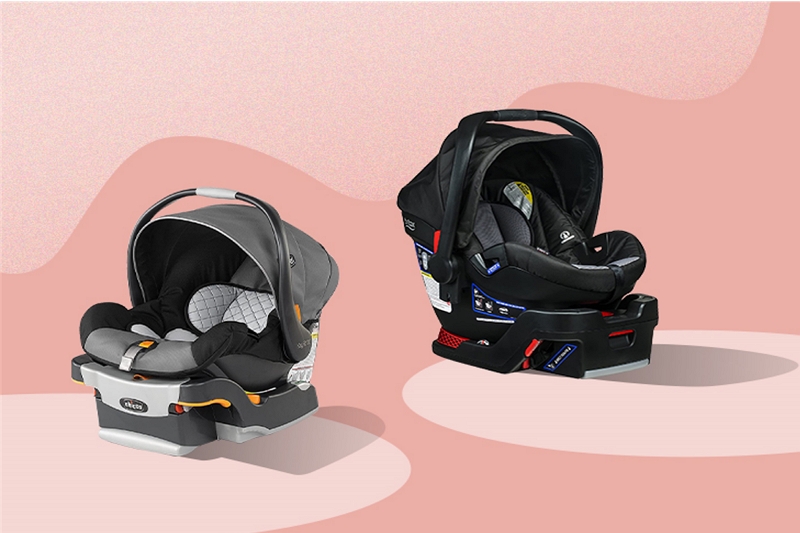When do you change baby car seat is a very important question that many parents ask when they are preparing for their little one to take the next step in life.
In this post, we will discuss when to switch from a rear-facing infant car seat to a forward-facing toddler car seat and finally when it’s time for your child to use the adult belt-positioning system.

How To Know When To Change Baby Car Seat
There are four stages of baby car seats, which determine the stage they should be in when you start using them. The stages range from rear-facing to forward-facing and then a booster seat. Each stage has different requirements for height, weight, and age limits before moving on to the next one.
When your child outgrows these measurements it’s time to move up a stage or buy another car seat altogether if needed. Always check that the new car seat is suitable for your specific vehicle prior to purchase.
Here’s more information about each stage:
15-month-old babies start becoming interested in everything around them including windows so don’t leave this too late with any window clings!!! Babies can listen well for 14 months but are still not able to point at things with accuracy.
At this age, your baby is getting more mobile by crawling or trying to walk along with furniture and may begin climbing out of his crib if not yet successful in escaping. Babies can be distracted so you need a window cling that’s bright & colorful as well as fun for them to look at.
As they get older around 15 months old babies will start pointing accurately and enjoy looking at their favorite cartoon characters on the window clings!!!
It takes time but eventually they’ll show an interest in these especially if it has something familiar like Mickey Mouse or other Disney friends!! Some toddlers even try ripping down the decals thinking it’s some form of “toy” paper.
You should always check daily before naps/bedtime for any tears or marks on the decals. If you see that your toddler has ripped it down just re-apply with super glue to make sure it’s secure and clean before bed/nap!
How Long Do You Keep A Baby In Infant Car Seat?
Infant car seats are used to secure infants and toddlers during transport via vehicle. Car safety restraints should be replaced approximately every five years, according to the American Academy of Pediatrics (AAP).
The AAP also recommends that parents keep their child in a rear-facing infant seat for as long as possible; there is no set time frame for when an infant needs to graduate from his or her infant car seat.
As with any other equipment, it’s important not only to follow product recommendations but also to ensure proper installation each time you use your baby’s car seat by following both manufacturer instructions and National Highway Traffic Safety Administration guidelines.
When children outgrow the maximum weight limit of their forward-facing convertible car seats it may be necessary to replace them.
How Do You Know When Your Child Has Outgrown Their Car Seat?
Each car seat has a weight and height limit, which is typically printed on the side of each car seat. If your child exceeds any of these limits it may be time to purchase a new car seat that can accommodate their growth.
Children who are still within their baby seats for too long have been known to develop spinal curvature from lack of support in the back area during this period.
Four years is an extremely long amount of time when talking about children’s safety products! In addition, if you notice mold growing inside your child’s baby carrier or problems with buckles then these need to be replaced immediately as well due to health concerns associated with bacteria build-up in dirty material types such as leather and cloth items over extended periods of use.
What Is The Next Car Seat After Newborn?
There is a lot of time between when you first bring your baby home and when they start to sit up on their own. The next car seat after the newborn would be an baby carrier with a five-point harness that can hold the child in until he or she reaches 20 pounds, at least.
These seats will typically have an adjustable recline feature so babies can sleep comfortably as well as head support and foot padding for comfort and safety during travel by automobile.
As long as the carrier has these basic features, it should meet all legal requirements for use inside a vehicle from birth through preschool years depending upon where you live.
When Can Baby Face Forward In 2021?
Babies should face forward when they can hold up their heads and neck without assistance. When babies are able to sit upright on a parent’s lap, we recommend you keep them facing backward until two years of age or 20 pounds (whichever comes first).
This is because the structure of the infant car seat limits movement in any direction other than back.
The best way that an infant gets more use out of his or her rear-facing seats is by staying seated as much as possible for naps and long trips.
When infants grow too big for this position, parents may choose to switch from a rear-facing child safety seat to a front-facer.
